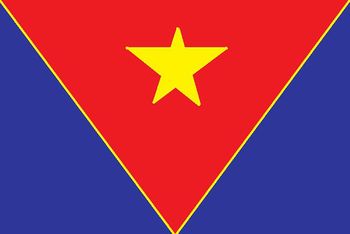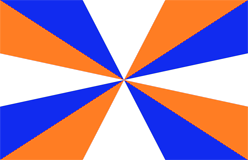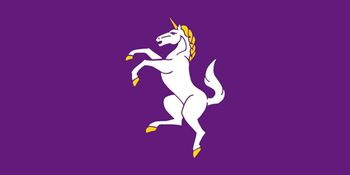Flag of Hamland: Difference between revisions
No edit summary |
|||
| (6 intermediate revisions by 2 users not shown) | |||
| Line 6: | Line 6: | ||
The first flag, which has been lost to history, predates the country's claim on Micras as well as its Monarchy. It was enacted during the brief communist era at the start of its existence. It is the flag which was in existence for the shortest amount of time and is rarely referenced or used today due to this. Its most important contribution to the modern flag was the star of Hamland which remained uncrowned due to the lack of a monarchy. This feature inspired the star which appeared in the second flag. | The first flag, which has been lost to history, predates the country's claim on Micras as well as its Monarchy. It was enacted during the brief communist era at the start of its existence. It is the flag which was in existence for the shortest amount of time and is rarely referenced or used today due to this. Its most important contribution to the modern flag was the star of Hamland which remained uncrowned due to the lack of a monarchy. This feature inspired the star which appeared in the second flag. | ||
The flag was originally designed by the first King on the back of a notepad used in School. The design went through many stages and eventually became the settled symbol. | |||
This flag was used when opening relations at the very beginning of the state and so did see use and recognition by other states despite its short lifespan of only a few months. | |||
== British Territory Flag == | == British Territory Flag == | ||
| Line 13: | Line 17: | ||
The second flag came into existence briefly before Hamland claimed land on Micras. This flag notably introduced the Star of Hamland, a symbol of the state which remains to this day. The star itself represents the nation and the crown represents its Monarchy and Government. The Star of Hamland now features on many regional flags in the [[Commonwealth of Hamland]] such as that of the [[Region of the Isles]]. | The second flag came into existence briefly before Hamland claimed land on Micras. This flag notably introduced the Star of Hamland, a symbol of the state which remains to this day. The star itself represents the nation and the crown represents its Monarchy and Government. The Star of Hamland now features on many regional flags in the [[Commonwealth of Hamland]] such as that of the [[Region of the Isles]]. | ||
This flag was adopted reflecting the country's foundation by a British citizen as well as the fact that the original intention of the country was to remain a Crown Dependency if it were to secede from the UK. This never occurred and following the turn towards simulationism the union flag lost favour and the state flag was altered. It is notably comparable to the current flag of the Commonwealth which borrows heavily from the design. | This flag was adopted reflecting the country's foundation by a British citizen as well as the fact that the original intention of the country was to remain a Crown Dependency if it were to secede from the UK. This never occurred and following the turn towards simulationism the union flag lost favour and the state flag was altered. It is notably comparable to the current flag of the Commonwealth which borrows heavily from the design. The banner at the bottom of the star was lost and no longer is deemed necessary. Generally the small banner can be found in cheap knock-off reproductions of the flag produced in Taeland. | ||
The British Territory Flag was used on Micras before Hamland had entered the [[United Commonwealth]]. People in Hamland who support a return to these days of isolationism have tried to adopt this flag. In recent years this movement has become less popular and the flag is consigned to history. | |||
== First Saltire Flag == | == First Saltire Flag == | ||
| Line 31: | Line 36: | ||
The fourth iteration of the Flag of Hamland was introduced in 2010 following various reforms to the borders of the state. It was felt that the new changes in the state should be reflected by a change in the flag which darkened the blue and removed the Star of Hamland. Aside from this, there were very few alterations to the flag and it remained the state flag until 2013 when it was replaced by the flag of the Commonwealth. | The fourth iteration of the Flag of Hamland was introduced in 2010 following various reforms to the borders of the state. It was felt that the new changes in the state should be reflected by a change in the flag which darkened the blue and removed the Star of Hamland. Aside from this, there were very few alterations to the flag and it remained the state flag until 2013 when it was replaced by the flag of the Commonwealth. | ||
The flag | The new flag was seen as neater and more pleasing than the previous. For this reason it was a popular move by the government which was well received by the public. The slight change meant that the old flag could continue to be used by those who could not afford to update their flags and that not much confusion was caused. For example, it is still common to find one or two of the first saltire flags to be flown at football games. | ||
The flag remains the regional symbol of Hamland within the Commonwealth and is still commonly found flown throughout the region. It is quite unpopular with people from parts of the Commonwealth which are antagonistic towards Hamland. | |||
== Commonwealth Flag == | == Commonwealth Flag == | ||
| Line 40: | Line 46: | ||
In 2013 during a return to activity, the state was reorganised to recognise the diversity of the constituent nations of the country and so the flag was altered to reflect a new Commonwealth beyond Hamland. The new flag used the colours of the previous and was developed from a proposal by Duke Sinclair which had a band running horizontally through the middle. Lord Lewis proposed that the flag be white, now accepted the colour of the Commonwealth, but that the top and bottom of the flag retain the traditional colours at the edges to prevent it looking like a flag of surrender when there are no winds. This flag reintroduced the Star of Hamland as a symbol of the Government of the Commonwealth retaining the Seneschal (Protector) of Hamland as Head of State. | In 2013 during a return to activity, the state was reorganised to recognise the diversity of the constituent nations of the country and so the flag was altered to reflect a new Commonwealth beyond Hamland. The new flag used the colours of the previous and was developed from a proposal by Duke Sinclair which had a band running horizontally through the middle. Lord Lewis proposed that the flag be white, now accepted the colour of the Commonwealth, but that the top and bottom of the flag retain the traditional colours at the edges to prevent it looking like a flag of surrender when there are no winds. This flag reintroduced the Star of Hamland as a symbol of the Government of the Commonwealth retaining the Seneschal (Protector) of Hamland as Head of State. | ||
The new flag is more popular on the Island of [[Taeland]] which has had a long standing dislike for Hamland seeing them as effeminate and imperialistic. This cynicism towards Hamland means that the previous saltire flags were often burned or stolen when flown from public buildings, particularly during the rise of the Red Hand in 2007. The presence of a flag which represented all of the nations of the Commonwealth was greeted with slightly more optimism than the old saltire. | |||
This flag is flown alongside all regional flags in the Commonwealth outside of any public building. Although it is not law, it has become established protocol and there are very few exceptions to this rule, even in Taeland. | |||
== Other Flags == | == Other Flags == | ||
| Line 49: | Line 58: | ||
The Flag of the Hammish Monarchy is the Purple Flag with the White Unicorn. The White Unicorn is an important symbol for Hamland being present in its ancient Religion as a god-like creature which granted special powers to those it visited. The purple background was the colour of the Monarchy and so became a popular flag for Monarchists in Hamland to use. The symbolism in the flag is used today by the Hamland National Party which uses the colour purple and the symbol of the Unicorn (the national animal of Hamland). Notably, the unicorn is another feature Hamland shares with Scotland as they both have the same national animal. | The Flag of the Hammish Monarchy is the Purple Flag with the White Unicorn. The White Unicorn is an important symbol for Hamland being present in its ancient Religion as a god-like creature which granted special powers to those it visited. The purple background was the colour of the Monarchy and so became a popular flag for Monarchists in Hamland to use. The symbolism in the flag is used today by the Hamland National Party which uses the colour purple and the symbol of the Unicorn (the national animal of Hamland). Notably, the unicorn is another feature Hamland shares with Scotland as they both have the same national animal. | ||
[[File:NavalJack zpsd4071d2f.png|thumb| | [[File:NavalJack zpsd4071d2f.png|thumb|left|350px|Flag of the Commonwealth's Navy]] | ||
[[File:Q6KonB9.jpg|thumb| | [[File:Q6KonB9.jpg|thumb|left|350px|Flag of the Commonwealth's Army]] | ||
[[File:640px-VA Flag Proposal Tibbetts.jpg|thumb|left|350px|Flag of the Hammish Monarchy]] | [[File:640px-VA Flag Proposal Tibbetts.jpg|thumb|left|350px|Flag of the Hammish Monarchy]] | ||
[[Category:Hamland]] | |||
[[Category: Flags]] | |||
Latest revision as of 19:14, 31 December 2019
The Flag of Hamland has changed much over its history. Many symbols reappear throughout these such as the Star of Hamland as well as the colours of Blue, white and gold. Since becoming a region of the Commonwealth of Hamland the last saltire remains as a regional flag with the Commonwealth flag being the official flag of the state.
First Flag
The first flag, which has been lost to history, predates the country's claim on Micras as well as its Monarchy. It was enacted during the brief communist era at the start of its existence. It is the flag which was in existence for the shortest amount of time and is rarely referenced or used today due to this. Its most important contribution to the modern flag was the star of Hamland which remained uncrowned due to the lack of a monarchy. This feature inspired the star which appeared in the second flag.
The flag was originally designed by the first King on the back of a notepad used in School. The design went through many stages and eventually became the settled symbol.
This flag was used when opening relations at the very beginning of the state and so did see use and recognition by other states despite its short lifespan of only a few months.
British Territory Flag
The second flag came into existence briefly before Hamland claimed land on Micras. This flag notably introduced the Star of Hamland, a symbol of the state which remains to this day. The star itself represents the nation and the crown represents its Monarchy and Government. The Star of Hamland now features on many regional flags in the Commonwealth of Hamland such as that of the Region of the Isles.
This flag was adopted reflecting the country's foundation by a British citizen as well as the fact that the original intention of the country was to remain a Crown Dependency if it were to secede from the UK. This never occurred and following the turn towards simulationism the union flag lost favour and the state flag was altered. It is notably comparable to the current flag of the Commonwealth which borrows heavily from the design. The banner at the bottom of the star was lost and no longer is deemed necessary. Generally the small banner can be found in cheap knock-off reproductions of the flag produced in Taeland.
The British Territory Flag was used on Micras before Hamland had entered the United Commonwealth. People in Hamland who support a return to these days of isolationism have tried to adopt this flag. In recent years this movement has become less popular and the flag is consigned to history.
First Saltire Flag
The third flag of the Kingdom was adopted on the 11th September 2007, a day before the first anniversary of Hamland. This flag got rid of the Union flag and introduced the Hammish Saltire, which remains a symbol of Hamland today. It also introduced the colours of Blue and Gold which are the national colours of the Commonwealth too.
The flag was based on a proposal by then Prime Minister Duke Juan, who thought that the flag should represent the Scottish background of the state. It was originally without the gold in the flag. The King proposed that the flag have Gold in it to make it more distinctive and thus the national colours had become white, gold and blue.
Hamland Regional Flag
The fourth iteration of the Flag of Hamland was introduced in 2010 following various reforms to the borders of the state. It was felt that the new changes in the state should be reflected by a change in the flag which darkened the blue and removed the Star of Hamland. Aside from this, there were very few alterations to the flag and it remained the state flag until 2013 when it was replaced by the flag of the Commonwealth.
The new flag was seen as neater and more pleasing than the previous. For this reason it was a popular move by the government which was well received by the public. The slight change meant that the old flag could continue to be used by those who could not afford to update their flags and that not much confusion was caused. For example, it is still common to find one or two of the first saltire flags to be flown at football games.
The flag remains the regional symbol of Hamland within the Commonwealth and is still commonly found flown throughout the region. It is quite unpopular with people from parts of the Commonwealth which are antagonistic towards Hamland.
Commonwealth Flag
In 2013 during a return to activity, the state was reorganised to recognise the diversity of the constituent nations of the country and so the flag was altered to reflect a new Commonwealth beyond Hamland. The new flag used the colours of the previous and was developed from a proposal by Duke Sinclair which had a band running horizontally through the middle. Lord Lewis proposed that the flag be white, now accepted the colour of the Commonwealth, but that the top and bottom of the flag retain the traditional colours at the edges to prevent it looking like a flag of surrender when there are no winds. This flag reintroduced the Star of Hamland as a symbol of the Government of the Commonwealth retaining the Seneschal (Protector) of Hamland as Head of State.
The new flag is more popular on the Island of Taeland which has had a long standing dislike for Hamland seeing them as effeminate and imperialistic. This cynicism towards Hamland means that the previous saltire flags were often burned or stolen when flown from public buildings, particularly during the rise of the Red Hand in 2007. The presence of a flag which represented all of the nations of the Commonwealth was greeted with slightly more optimism than the old saltire.
This flag is flown alongside all regional flags in the Commonwealth outside of any public building. Although it is not law, it has become established protocol and there are very few exceptions to this rule, even in Taeland.
Other Flags
Hamland has other flags for its army, navy and Monarchy which are available below.
The Flags of the Navy and army were introduced during 2013. The Army's flag was originally intended as a republican revolutionary flag but was granted to the Army as republicanism in Hamland had cooled off over time due to the abdication of the first King. The Seneschal proposed the navy's flag which retains a similar colour scheme. The flags are used by all armed forces in the Commonwealth's army.
The Flag of the Hammish Monarchy is the Purple Flag with the White Unicorn. The White Unicorn is an important symbol for Hamland being present in its ancient Religion as a god-like creature which granted special powers to those it visited. The purple background was the colour of the Monarchy and so became a popular flag for Monarchists in Hamland to use. The symbolism in the flag is used today by the Hamland National Party which uses the colour purple and the symbol of the Unicorn (the national animal of Hamland). Notably, the unicorn is another feature Hamland shares with Scotland as they both have the same national animal.







